Tour & Design
The front of the Zen X-Fi looks like a standard media player that's been turned on its side. On the left is the 2.5-inch display, to the right of which is an array of buttons. The center nine buttons will help you with navigation to varying degrees. The center key is select, the keys bordering it non-diagonally are up, down, left, and right respectively. The top and bottom key on the left will jump to the start or end of a list, while the keys on the right side will skip up/down five or so items.

Left
The left side of the device is featureless.

Right
The right size of the X-Fi has four interesting items. The two most obvious features are the mini USB port for data/charging and the standard 1/8-inch headphone jack. On the other side of the headphone jack is a green LED that will light up when the device is turned on. Beside the mini USB port is a small reset button.

Top
The top of the X-Fi has an SD card slot and a small microphone port.

Bottom
The bottom of the X-Fi has a thin slot, inside of which is the internal speaker.

Back
Other than standard branding, the X-Fi's back is where it keeps it's power/hold switch.

Battery Out
Creative doesn't want you fooling around with the battery, so they don't give you access to it.
In addition to the X-Fi, you'll find a pair of headphones (with three sets of sleeves total), the shortest mini USB cord we've ever seen, some documentation, and a mini CD full of software.

While the X-Fi probably won't break easily, the platic case feels a bit flimsy compared to the metal cases we've seen on other devices. We were able to scuff the texture off the back of the case with a penny and carve it up pretty easily with a pair of keys. The front of the screen seems to be much more durable, although it isn't as bullet-proof as the Sony Walkman 16GB's screen.

The Creative X-Fi is a good looking device. The front is a glossy black and the back is a sharp looking gray. The device is small, sleek, and, most importantly, doesn't look like an iPod. The media player market is so super-saturated with iPods that it's hard to imagine something that both looks good and doesn't look like an iPod. The X-Fi manages to do this with a nice, subtle, more professional look. You wouldn't feel embarrassed having your X-Fi with you at the office, or like you're pulling a rainbow out of your pocket every time you want to switch songs.
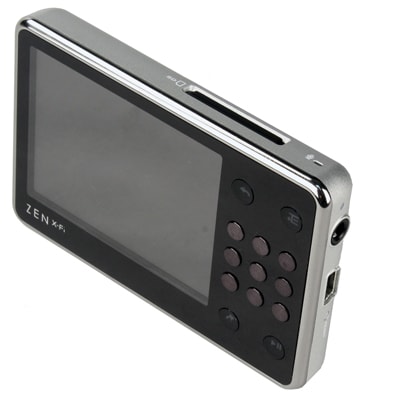
The Creative Zen X-Fi isn't the smallest media player on the market, but it is pretty small. In terms of its face dimensions, it's slightly smaller than average. This size advantage gets negated somewhat by the device being a bit thicker than a lot of modern media players: in a tight pocket the X-Fi will create a tiny protrusion. The device is an average weight as well: 2.4 ounces. There are plenty of smaller media players out there, but the X-Fi is still a tiny device.
**Supported File Types*** (6.38)*
The Creative X-Fi will play back MP3, WMA, AAC4, WAV, and Audible (formats 2, 3, and 4) audio files. Your videos will work as long as they're in MJPEG, WMV, or MPEG-4 format (MPEG-4 includes DivX and XviD files). Included software can transcode from other formats providing appropriate codecs are installed. The device will only support JPEG pictures, but the included software can transcode BMP, GIF, PNG, and TIFF files.
Hardware
**Physical Controls*** (7.50)*
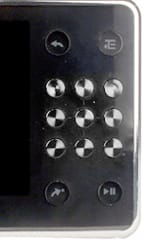
The X-Fi has a different control setup than you're probably used to seeing. Instead of a d-pad, the X-Fi sports a 9-key array, none of which are labeled in any way. The center key is select, while the buttons directly adjacent to it serve as d-pad buttons. The buttons in the left corners are home and end keys and will jump to the top or bottom of a menu. The keys on the right are a bit less straight-forward. They'll skip through lists either up or down, but we're not entirely sure what determines how many items they skip over. For example, if you start with the cursor at the top main menu item, then press the bottom right button, you'll skip to the Extras menu. Start with the cursor on the second item in the menu and you'll still skip down to Extras. Once you move down a few more items, however, you'll skip to the item after Extras and so on. It seems as though the X-Fi has specific places it wants to skip to, as long as that item is 5 or more items away. In any case, the buttons will help you navigate lists, even if they do work is slightly mysterious ways.
There are also four other keys that are evenly spread out above and below the keypad. The top left button is the menu/back button. When you press it it serves as a back button, but if you hold it it'll jump to the home screen. To its right is the options button. Simply push it while in a menu to view the options available to you. The bottom left button is a customized shortcut button. You assign the button by first highlighting a feature or menu, then pressing and holding the button. The bottom right button is good ol' play/pause .
The Creative Zen X-Fi display is QVGA, meaning it has 320 x 240 resolution. This is a standard resolution for modern media players. Some higher-end devices or media players focused on movie playback will have much higher resolutions. For example, the the Archos 705 has a resolution of 800 x 480. If you held the X-Fi up to the Archos 705, you'd notice the difference. Since few people watch videos on two devices simultaneously, most won't have any problem watching their video on the X-Fi.
The X-Fi's screen has a 2.46-inch diagonal. This is a good size; it's above average for media players and slightly bigger than the average cell phone screen. We'd recommend a slightly bigger screen for users who plan on watching a lot of videos. Typical users or music-only people should be fine with the X-Fi's screen.
The numbers of pixels per inch (PPI) of screen is what allows images to be sharp and colors to be vivid. Spread out pixels (low PPI) mean washed out colors and blurry lines. A slightly larger than average screen holding an average resolution leads to a slightly below average pixel density. This means colors will seem ever-so-slightly washed out and lines won't appear to be as sharp as they do on higher-quality displays. If you plan on watching a lot of video, the X-Fi will be adequate, but there are many devices out there with a better picture.
The Creative X-Fi has five different brightness settings, and was capable of outputting 536 cancelas per square meter. This is a great output potential, making it a better make-shift flashlight than the Archos 5 or iPod Touch, both of which have c/m2 measurements around 300 and 400 respectively.
**Built-in Speakers*** (6.47)*
The X-Fi does have a built-in speaker, which is capable of 82.0 decibel output. The quality of the sound it output wasn't great, but it was acceptible for such a tiny device. Overall, we're simply happy that the speakers were included in the first place.
**Cable Connectivity*** (8.10)*
The X-Fi uses a mini USB plug to connect to a PC for data transfer or battery charging. While we definitely prefer a standardized port for data, we were a bit disappointed by the absurdly short cord the X-Fi came with. The cord itself is barely 4 inches from end to end, and that's including the parts that would actually fit into your computer and the device. This means you'll realistically have a 4-inch tether for your media player. While this is fine on a laptop, the shortness is a bit silly on a desktop computer: the device will dangle from the USB slot like low-hanging fruit. The headphone jack, on the other hand, is a standard 1/8-inch affair, which is far more professional.
While the Zen X-Fi might have 16GB of total storage, not all of that can be dedicated to your music: some has to be reserved for the device's operating system and other software. In terms of actual storage space, the X-Fi will provide you with 14.9 GB. This is 1.1 GB off from the advertised 16GB, which is a bit much, but not enough to make the 16GB figure an outlandish claim.
**External Storage*** (11.00)*
The Creative X-Fi will accept SD or SDHC cards. Currently this means you have the option of adding at least another 32GB of memory to the device. SDHC cards keep growning, however, so as soon as 64GB cards or higher are available, you'll be able to use them.
Typically media players do not support any type of external storage, especially with the capacity to triple or quintuple your current storage space.
We test battery life by starting a looped playlist and letting it play until the battery runs out. The Creative X-Fi lasted for 6 hours, 5 minutes, which wasn't very good. At this rate, you'll have to charge the device every night. Also, we noticed the X-Fi tends to crash when it gets very low on batteries and wont' respond unless you use the reset button. The manufacturer-stated battery life for the X-Fi is 24 hours. Though the X-Fi's actual battery life is significantly off from this, most of the media players we've tested have also fallen short of their maker's expectations.
Media Interface
While on the Now Playing screen, up the top-center and bottom-center buttons in the 9-key array will adjust the volume. The left-center and right-center buttons will skip from song to song, or, if held, will fast-forward and rewind. The play/pause button will perform its eponymous function. The back of the device is where the lock switch is. Unfortunately, only the play/pause button is dedicated to its function: outside of the Now Playing screen, the other buttons either perform other functions or stop working entirely. This is slightly annoying since it means you'll have to return to the Now Playing screen before you can adjust the volume or skip songs. While you can access volume via the Options key, if you want to skip songs you'll have to get back to the Now Playing screen. The quickest way to get back to the Now Playing screen is to hit Play/Pause.
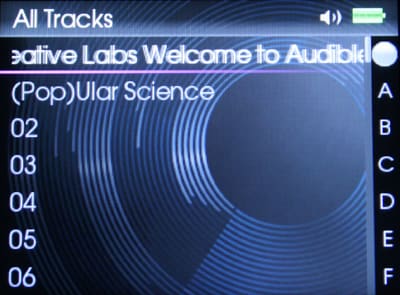
Hitting the options key will also give you a Seek To option, which will let you move a slider bar to a specific point in the song. This functionality is a nice inclusion, but is a bit offset by the overwhelmingly slow pace at which the slider actually moves.
**Advanced Playback*** (8.25)*
While a song is playing, you'll be able to see its place in the playist, the song's title, the album name and its art, the name of the artist, and the current playback setting. The current position in the song is denoted by two timers, one that counts up and one that counts down, and a slider bar.
The play settings available to you are repeat track, repeat all, shuffle, shuffle repeat, track once. You can only implement one of these at a time, but since shuffle repeat is an option there's really no reason to double up. The 'track once' setting is the same as shuffle, only it'll won't repeat songs until you've exhausted the playlist.
One interesting feature is the ability to bookmark certain points in a song. This is especially good for those who listen to long podcasts or audiobooks (hence the feature's name). To bookmark your spot, first of all, pause the track (you don't have to, but playback will progress as you browse the menu, so you'll have to be quick). Then just select 'Set Bookmark' from the options menu. You can access your bookmarks from the Music menu, they're located at the bottom of the list.
Media Management
There are four tools at your disposal for browsing menus. The primary way to navigate menus is with the top-center and bottom-center keys, which will auto-scroll when the key is held. The top-left and bottom-left keys jump to the start or end of a list. You can press the right-center key to access an alphabetical scroll (you can select a letter to jump to all items beginning with that letter). The top-right and bottom-right keys will partially skip down a list, but they're a bit unreliable since they often skip down by an arbitrary amount.
While there were many tools at our disposal, the X-Fi scored poorly on our timing test. This test measures how long it takes to skip from one specific song to another specific song. The X-Fi did this a few seconds slower than our current average time. Part of the reason for this poor score is that the X-Fi is somewhat slow to respond to inputs. Also, while the searching tools are nice, they're a bit cumbersome to use.
You can view your music by playlist, album, artist, genre, or all tracks in their entirety. Video files can be viewed by 'video,' which shows all your videos, or by TV, which is a label applied by Creative's sync software.
You can search through your library in a few ways. You can use the top-left and bottom-left buttons to skip to the beginning or end of a playlist. The top-right and bottom-right buttons skip through playlist items, but don't really do so in a logical way. Of course, you can always opt to use the top-center and bottom-center keys to scroll through the list. Holding the keys down will autoscroll.
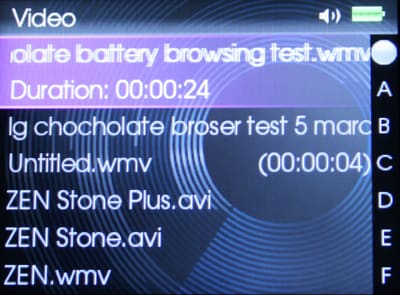
Making playlists on the X-Fi isn't particularly easy to do, initially, mainly because there's no 'New Playlist' option. What you can do is save a song that's currently playing as a playlist, then add other songs to it via the options button and the 'Add to selected' command. This is somewhat unintuitive and clumsy, but once you've started adding things to a list the process is straight-forward.
The device also comes with quite a few built-in playlists available, courtesy of the DJ feature. These playlists will change dynamically based on your listening habits and other criteria: recently added, album of the day, random play all, most popular, rarely heard, highly rated, and yet to be rated. If you choose to use the Creative Centrale software, you will also be able to sync over a few more playlists, the most significant of which is the 'recently added' playlist.
**Equalizer & Filters*** (10.75)*
The Creative Zen X-Fi's equalizer has 5 different frequency bands for you to fool around with 80Hz, 250Hz, 1kHz, 4kHz, 13kHz. Each band has each of which has 13 different levels (-6 to +6). There are also 8 equalizer presets: acoustic, classical, disco, jazz, new age, pop, rock, vocal.
The Zen X-Fi's name is partially derived from Creative's like of X-Fi products, which hinge on some unspecified audio quality. As such, you can opt to turn on the X-Fi crystalizer or expander, both of which alter how your music sounds. The crystalizer will, according to the manual, 'made audio richer, clearer, and closer to the original sound.' The expander will 'give sound a realistic and 'live performance' feel.' We attest to the fact that both of these features change how the audio sounds, but we'll leave it up to you and your own subjectivity to determine whether or not they're worth switching on.
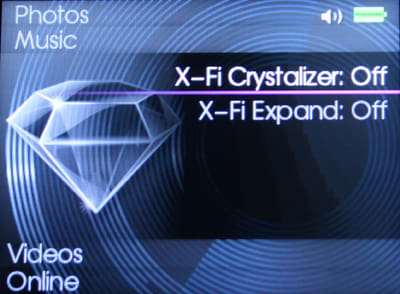
Other Media Software
The photo album software on the X-Fi has a better interface than a lot of media players. You can view pictures as either thumbnails or in list view. and pictures are sorted by folder, recently browsed, or whether or not they were imported.
When viewing a picture, you can zoom in and pan around. You can also rotate the images, both as a viewing tool and as an editing tool. Though a simple feature, most media players don't include any sort of photo editing at all. You can also save a zoomed-in view as your background.
You can only view slideshows on the device, as created on the desktop software. The slideshows are really basic, so we're not sure why the functionality wasn't simply included on the device.
While you can stream podcasts over Creative's Mediabox or Zencast services, there's no way to download or sync over podcasts.
**Audio Recording / Voice Notes*** (4.00)*
The audio recording software is pretty basic. You can start recording, split your recording as you record, and stop. Audio recordings receive their own special folder so they won't randomly pop up when you're listening to the 'shuffle all' playlist.
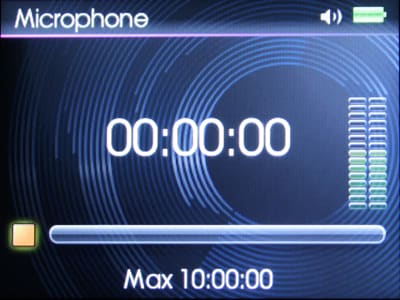
Performance
**Frequency Response*** (7.30) [

](https://www.reviewed.com/mediaplayers/content/How-We-Test.htm#Frequency_Response)*
Our first test looks at frequencies, examining how well an MP3 player like the X-Fi plays back all of the tones that make up your music. We do this by playing back a special sound file that contains a range of frequencies, with our testing system listening in. This then produces the graph on the right, which shows the response from the low frequencies (on the left) to the high (on the right). The ideal here is a flat line, which would indicate that the MP3 player plays back all frequencies at equal volume.
The X-Fi did a reasonable job here; although the response is flat for most of its length, it does get rather bumpy towards the end, with some frequencies being slightly exaggerated and others slightly supressed. These are mostly minor bumps and dips, though, and few users are likely to notice them. More of an issue is the very high frequencies, though; the player seems to cut these off a little quicker than we generally like to see, which might lead to some high frequency details getting slightly lost in the mix. But this only happens at very high frequencies, and generally the frequency responsne of the X-Fi is acceptable.
One thing to note here is that we disable the equalizer for this test, as this alters the frequency response to appropriately enhance the sound.

](https://www.reviewed.com/mediaplayers/content/How-We-Test.htm#Distortion)
When your music just doesn't sound right, distortion could be to blame. Distortion refers to differences between the origional sound and what you get; problems such as clipping and compression mean that you don't get the original sound. We test for this using a special sound that simulates music because it number of frequencies being played simultaneously, which is a better indicatior of distortion than a single tone.
We found some issues here; the X-Fi had definite distortion across most of the frequency range. To push them to their maximum performance (or lack thereof), we test media players at their maximum volume, which also tends to maximize the distortion, if it is present. The distortion would probably be significantly less if the volume was set lower, but it's not a good sign when a player has this level of distortion.

](https://www.reviewed.com/mediaplayers/content/How-We-Test.htm#cross_talk)
There are two sides to your music; the left and right channels that get sent to the left and right headphones. And your music should stay that way; what's playing in the left channel should never end up in the right one. That's what we test here; our testing system looks to see if any of one channel gets into the other, a problem called crosstalk.
The X-Fi did not have any major issues here; we measured the amount of crosstalk at around -75.6 decibels, which means that it will be inaudible to all but the most sensitive of ears.

](https://www.reviewed.com/mediaplayers/content/How-We-Test.htm#Output_power)
Media players have to drive headphones, and that's what we test here; how much energy they can produce to drive a bigger set of headphones. Although every player has the wattage to power the headphones they come with, many players lack the muscle to drive a bigger set of headphones, outputting only a handful of milliwatts. The X-Fi didn't have this issue; driving a reference load of 10 ohms, we measured the peak output of the headphone socket at 27.4 milliwatts, which should be enough to drive all but the biggest, baddest headphones. . However, it should be noted that this might be why the distortion is high; if the amplifier within the player is being pushed too hard to improve the output power, distortion can be the result.

](https://www.reviewed.com/mediaplayers/content/How-We-Test.htm#Output_power)
Noise is an inevitable fact of life with media players; the converters that turn the digital data back into analog sound and the amplifiers that boos this to the right levels all add some amount of noise. We didn't find much noise from these in the X-fi, though; we measured the signal to noise ratio at 61.9 decibels. Higher is better in this test - it means that there is a wider difference between the signal (the music) and the noise that the amplifiers and converters create. Although other players have higher signal to noise ratios (the iPod Nano, for instance, had a signal to noise ratio of 92.99), the X-Fi has a higher enough rating here that noise should not be a problem.
**Included Headphones*** (8.27) *[

](https://www.reviewed.com/mediaplayers/content/How-We-Test.htm#Included_headphones)
Most of the headphones that are included with media players are, to be honest, awful; cheap, grungy and leaky. The headphones that came with the X-FI were a pleasant surprise, though; we found that the in-ear headphones had decent frequency response, low distortion and could handle plenty of volume. They were also resonably good at isolating you from the outside world, blocking a lot of sound and not letting much sound escape. Although audiophiles may still want to invest in a better pair of headphones, the headphones bundled with the X-Fi are pretty darn good.
Internet & Wireless
The Creative Zen X-Fi supports wifi on IEEE 802.11 b/g, and can handle WEP, WPA-PSK, or WPA2-PSK security. This is the typical set of wifi capabilities. We liked the support of both WEP or WPA, since some devices only support one or the other.
**Music Store Client*** (0.0)*
The Zen X-Fi does not have a built-in music store client, which is a shame since it has wireless connectivity.
**Streaming Audio / Video*** (9.00)*
The Creative Zen X-Fi supports streaming audio and video, and has an on-board FM radio client with 32 station presets. You can also stream media from Creative's Zencast or Mediabox services. Since the device doesn't have a browser, however, you won't be able to access popular video sharing websites like Vimeo or YouTube.
Synchronization
**Synchronization Ease of Use*** (4.50)*
It stands to reason that, since the Zen X-Fi has wireless connectivity and the ability to stream audio/video from your home PC, you'd also be able to sync the device wirelessly. Unfortunately, as logical as this thought stream is, it is not the reality we live in. Instead of wireless synchronization, you'll have to rely on the most itty-bitty USB cord ever. Once you've come to terms with such a short leash, you can look forward to using Creative's sync software, Creative Centrale. This software features a layout similar to iTunes, Windows Media Player, and just about every sync/media player out there (excepting Sony's, but Sony's is downright horrible). Using this software, you'll be able to sync over playlists or loose songs, although there isn't an option to automatically sync things over. The software itself is easy to use, but it's not all that useful -- especially since you can just drag & drop files onto the device itself.
**Synchronization Features & Support*** (3.50)*
Again, your Zen X-Fi will be recognized as a storage device when you connect it. Since iPod has started a trend of making users dependent on software to transfer their media, media players like the Zen X-Fi are becoming fewer and further between, which is a shame. Want to toss a song on your media player quickly? Just connect it, open up Finder or Windows Explorer, drop it on there, and you can be on your merry way. Even better: want to take a song off your media player? On an iPod, you simply can't do this, which is incredibly annoying for those with multiple PCs and a non-centralized music collection, or for those who want their music on their work PC.
This feature aside, there isn't much that the synchronization software actually does in terms of adding functionality. It can sync over your audio recordings, which most software doesn't support, although most devices don't have an audio recording application either.
As alluded to earlier, one annoyingly absent feature is the ability to sync the device via wifi. The Creative Centrale software lets you stream music wirelessly to the device for playback purposes. Is it really that big of a leap from this functionality to synchronization? Hopefully a firmware update will come out that will allow this functionality.
**Other Synchronization Software Features*** (4.25) *
As a media player, the Creative Centrale software is adequate. As a media organizer it's not as invasive as iTunes, which may or may not be a good thing. You can change the tag info of your songs with the application, but doing so won't update your music's folder structure. Of course, if you're maintaining your own file structure this is a good thing, but we'd like to see the software offer such a service as an option.
One thing we should mention, however, is that the Creative Centrale software does handle pictures well. You can sort pictures by year, people, event, place, or by folder. You also use this software to make slideshows.
Probably the only important feature the Creative Centrale software provides is wirelessly streaming your media to your device. This is a neat little ability, especially if someone else is hogging the computer.
Organizer & Other Software
**Overall Interface*** (6.00)*
The Zen's software is well laid out. It's similar to the iPod Classic and Nano in that its interface is a series of lists. On the main menu, the highlighted item's text grows in size, accompanied by a small image that describes that menu item's functionality. At the top of the screen are the above two items in the list; below are the next two items. Clicking on an item in the main menu will cause a smaller menu to pop out with a list of options.
While straight-forward, there's really nothing exceptional about the Creative Zen X-Fi's software. In a world of touchscreens and aesthetic fluorishes, the X-Fi's software is a little boring and utilitarian.
**Personal Information Management**
The X-Fi does not have an address book. You'll have to trust another device with your contact information.
The X-Fi doesn't have a calendar application that you can add appointments to.
The X-Fi doesn't leet you keep track of todo lists.
**Memos & Other Documents*** (0.0)*
There is no memo software on the X-Fi. You also don't have access to any spreadsheet or document software.
The X-Fi doesn't come with any games on it.
You cannot download additional software for the X-Fi.
One cool feature the X-Fi has is an IM client for those who don't mind leeching a wifi connection. The service supports Windows Live Messenger and Yahoo Messenger. The device also features an alarm clock. You can set your songs as the alarm sound.
Conclusion
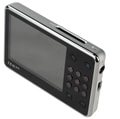
The Creative X-Fi packs a lot of features into a small and convenient package. It has decent battery life and a screen that's small, but bright and sharp. However, there are many things about it that don't work; the user interface is confusing, there are no information managment features and there's no way to add extra software to add in the fuctions you might need. And the audio quality has a few issues, and the screen is too small for extended video watching. But it is a small, convenient package, and it might be a worthy alternative to an iPod if you're prepared to live with the limitations.
Meet the tester
Mark Brezinski works on the Home Team, reviewing refrigerators, minifridges, dishwashers, washing machines, dryers, air conditioners, air purifiers, and fans.
Checking our work.
Our team is here to help you buy the best stuff and love what you own. Our writers, editors, and experts obsess over the products we cover to make sure you're confident and satisfied. Have a different opinion about something we recommend? Email us and we'll compare notes.
Shoot us an email